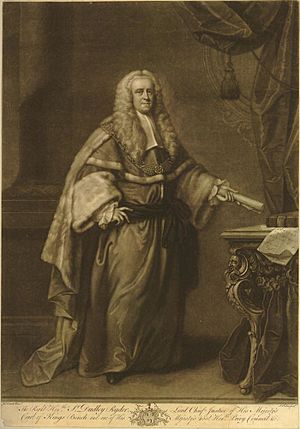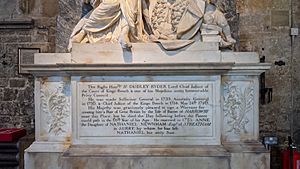Dudley Ryder (judge) facts for kids
Quick facts for kids
Sir Dudley Ryder
|
|
|---|---|
 |
|
| Solicitor General | |
| In office 1733–1737 |
|
| Monarch | George II |
| Prime Minister | Robert Walpole |
| Preceded by | Charles Talbot |
| Succeeded by | Sir John Strange |
| Attorney General | |
| In office 1737–1754 |
|
| Monarch | George II |
| Prime Minister | |
| Preceded by | Sir John Willes |
| Succeeded by | William Murray |
| Lord Chief Justice of the King's Bench | |
| In office 1754–1756 |
|
| Monarch | George II |
| Prime Minister | The Duke of Newcastle |
| Preceded by | Sir William Lee |
| Succeeded by | William Murray |
| Personal details | |
| Born | 4 November 16914 November 1691 – 25 May 1756 London, England |
| Died | 25 May 1756 (aged 64) London, England |
| Spouse | Anne Newnham |
| Children | Nathaniel Ryder |
| Parents | Richard Ryder Elizabeth Marshall |
| Alma mater | University of Edinburgh |
Sir Dudley Ryder (born November 4, 1691 – died May 25, 1756) was an important English lawyer and politician. He was a member of the British Parliament for many years. Later, he became a top judge, known as the Chief Justice of the King's Bench.
Contents
Early Life and Education
Dudley Ryder was born in London in 1691. His father, Richard Ryder, was a cloth merchant. Dudley went to school in Hackney, England. He also studied at universities in Edinburgh, Scotland, and Leiden, Netherlands.
Becoming a Lawyer
In 1713, he joined the Middle Temple. This was a place where people trained to become lawyers. He even kept a diary about his daily life! In 1719, he officially became a lawyer. He married Anne Newnham in 1733.
A Career in Law and Politics
Sir Dudley Ryder had a very busy career. He held several important jobs in the British government. He was known for his hard work and dedication.
Member of Parliament
In 1733, Ryder became a Member of Parliament (MP). This means he was elected to the British Parliament. He represented the area of St Germans. Later, he became the MP for Tiverton. He served in Parliament until 1754.
Key Legal Roles
Ryder also held high legal positions:
- Solicitor General: In 1733, he became the Solicitor General. This is a senior legal advisor to the government.
- Attorney General: In 1737, he was promoted to Attorney General. This is the chief legal officer of the government. He advised the King and Parliament on legal matters.
- Chief Justice: In 1754, he became the Lord Chief Justice of the King's Bench. This made him one of the most powerful judges in England. He was in charge of the main court for common law cases.
Other Achievements
In 1739, Ryder helped create the Foundling Hospital in London. This was a special place for abandoned children. He was one of its first leaders. In 1740, he was given the title of "Sir" (knighted) by the King.
Later Life and Legacy
Sir Dudley Ryder was a very respected person. He was known for being honest and fair. He died on May 25, 1756.
A Peerage Almost Granted
Just one day before he died, King George II signed a document. This document would have made Ryder a "peer." A peer is someone with a special noble title, like a Baron. However, Ryder died before he could officially accept this honor.
Family
Sir Dudley Ryder had one son, Nathaniel. Nathaniel later became the first Baron Harrowby.
Images for kids



